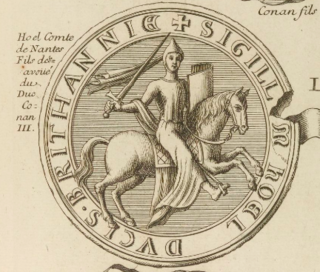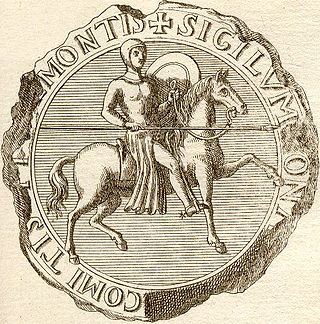
The Duchy of Brittany was a medieval feudal state that existed between approximately 939 and 1547. Its territory covered the northwestern peninsula of Europe, bordered by the Atlantic Ocean to the west, and the English Channel to the north. It was also less definitively bordered by the river Loire to the south, and Normandy, and other French provinces, to the east. The Duchy was established after the expulsion of Viking armies from the region around 939. The Duchy, in the 10th and 11th centuries, was politically unstable, with the dukes holding only limited power outside their own personal lands. The Duchy had mixed relationships with the neighbouring Duchy of Normandy, sometimes allying itself with Normandy, and at other times, such as the Breton–Norman War, entering into open conflict.
Constance was Duchess of Brittany from 1166 to her death in 1201 and Countess of Richmond from 1171 to 1201. Constance was the daughter of Duke Conan IV by his wife, Margaret of Huntingdon, a sister of the Scottish kings Malcolm IV and William I.
Geoffrey I, also known as Geoffrey of Rennes and Geoffrey Berengar, was Duke of Brittany from 992 until his death, and also Count of Rennes by right of succession. The eldest son of Duke Conan I of Brittany, he assumed the title of Duke of Brittany upon his father's death in 992. Brittany had long been an independent state, but he had little control over much of Lower Brittany.

Odo of Rennes, Count of Penthièvre, was the youngest of the three sons of Duke Geoffrey I of Brittany and Hawise of Normandy, daughter of Richard I of Normandy. Eudon married Agnes of Cornouaille, the daughter of Alan Canhiart, Count of Cornouaille and sister of Hoel II, Duke of Brittany who was married in 1066 to Eudon's niece Hawise, Duchess of Brittany.
Hoël II was Count of Kernev, from 1058 as Hoël V. On the basis of his marriage to Hawise, Duchess of Brittany, in 1066, he became Duke of Brittany jure uxoris.

Alan IV was Duke of Brittany from 1072 until his abdication in 1112. He was also Count of Nantes and Count of Rennes. His parents were Duchess Hawise and Duke Hoel II. He is also known as Alan Fergant. Through his father, he was of the Breton House of Cornouaille dynasty. He was the last Breton-speaking Duke of Brittany.

Conan III, also known as Conan of Cornouaille and Conan the Fat was duke of Brittany, from 1112 to his death. He was the son of Alan IV, Duke of Brittany and Ermengarde of Anjou.

Hoèl of Cornwall was count of Nantes, from 1148 to his death. He was raised the son of Duke Conan III and Maud FitzRoy, an illegitimate daughter of King Henry I of England. However, he was disinherited by his father when on his death-bed, as Conan III claimed that Hoèl was illegitimate and no son of his. Bertha then became heiress to Duke Conan's lands in Brittany, while Hoèl was allowed to remain Count of Nantes. He was accused by St. Bernard of Clairvaux of having an incestuous affair with his sister Bertha.
Odo II, Count of Porhoet was the son of Geoffroy, Viscount de Porhoët, and his wife Hawise. He became Duke of Brittany in 1148, jure uxoris, upon his marriage to Bertha, Duchess of Brittany.

Conan IV, called the Young, was the Duke of Brittany from 1156 to 1166. He was the son of Bertha, Duchess of Brittany, and her first husband, Alan, Earl of Richmond. Conan IV was his father's heir as Earl of Richmond and his mother's heir as Duke of Brittany. Conan and his daughter Constance would be the only representatives of the House of Penthièvre to rule Brittany.
Conan I, nicknamed Le Tort, was the Duke of Brittany from 990 to his death.
The counts of Nantes were originally the Frankish rulers of the Nantais under the Carolingians and eventually a capital city of the Duchy of Brittany. Their county served as a march against the Bretons of the Vannetais. Carolingian rulers would sometimes attack Brittany through the region of the Vannetais, making Nantes a strategic asset. In the mid-ninth century, the county finally fell to the Bretons and the title became a subsidiary title of the Breton rulers. The control of the title by the Breton dukes figured prominently in the history of the duchy. The County of Nantes was given to Hoel, a disinherited son of a duke. He lost the countship due to a popular uprising. That uprising presented an opportunity for King Henry II of England to attack the Breton duke. In the treaty ending their conflicts, the Breton duke awarded the county to Henry II.
The noble Breton family line of Porhoët was a French noble family in the middle ages, from around 990 through the 1200's. Notable members included Odo I, Odo II, and Alan I. Alan I would go on to form the Franco-Breton House of Rohan, which survives to the modern day.

Hawise of Rennes was Duchess of Brittany from 1066 until her death.
Bertha of Cornouaille, also known as Bertha of Brittany, was the Duchess of Brittany between 1148 until her death and Dowager Countess of Richmond. Bertha was the elder daughter of Conan III of Brittany by Maude, the illegitimate daughter of King Henry I of England. She was the last member of the Breton house of Cornouaille to reign over Brittany.
Margaret of Huntingdon was a Scottish princess and Duchess of Brittany. She was the sister of Scottish kings Malcolm IV and William I, wife of Conan IV, Duke of Brittany, and the mother of Constance, Duchess of Brittany. Her second husband was Humphrey de Bohun, hereditary Constable of England. Following her second marriage, Margaret styled herself as the Countess of Hereford.
Maud or Matilda Fitzroy, was a duchess consort of Brittany by her marriage to Conan III, Duke of Brittany. She was an illegitimate daughter of Henry I of England by one of his unknown mistresses.
Judicaël of Nantes was Count of Nantes from 992 to his death in 1004.
Judith of Nantes was titular Countess of Nantes from 1051 to her death in 1063.






